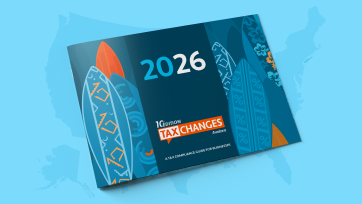
Communications tax is not sales tax 2.0
Buying a new smartphone with the latest bells and whistles is pretty straightforward. Pony up the big bucks upfront or finance it through multiple payments, either way you can expect sales tax to be tacked onto the bill. But the moment you want to actually use that phone for something more than taking videos of your dog’s latest trick, the costs become infinitely more complicated.
You’ll want a service plan so you’re able to upload your pup’s performance to Instagram, to call your brother in Chicago, and to hail an Uber to your Thursday night book club. Along with the charges for your 5G plan with unlimited data, you’ll pay a multitude of communications taxes, surcharges, and government fees.
Compared to businesses that are only on the hook for sales and use tax, your phone company is lugging a heftier load of responsibilities. And it isn’t alone. Countless companies that sell products and services incorporating a wide range of technologies such as Internet of Things (IoT), Software as a Service (SaaS), and network sensors have communications tax liabilities too.
You can have nexus everywhere you have customers
By their very nature, modern communications technologies including streaming, videoconferencing, and short message service (SMS) aren’t constrained by state borders. Sure, there may be wires, transmission towers, and satellites but digital signals don’t end when you reach the “Welcome to California” sign during your drive from Arizona. Businesses may have customers across the country and therefore nexus — the obligation to collect and remit communications taxes — in every state.
Two common ways to create sales and use tax nexus are physical presence nexus, such as having a store or employees, and economic nexus, which is tied to thresholds based on sales revenues and/or the number of transactions into a state. Communications taxes sometimes use similar criteria — it can vary depending on what type of service is being sold. And under certain circumstances, reselling services on someone else’s physical network can count toward having a physical presence in a state even when the seller doesn’t have infrastructure there.
More agencies mean more obligations and rates to track
Collecting sales and tax use tax usually starts with registering with the department of revenue in each state where you do business. Significantly more agencies can be involved when it comes to communications tax. You may have to deal with not only the state department of revenue, but the public utility commission, the 911 service administrator, and local revenue authorities wherever you have customers, as well as the Federal Communications Commission (FCC) and the Internal Revenue Service (IRS).
Though there are no city-level sales taxes in Florida and fewer than 70 county sales taxes, the Sunshine State currently has 481 local entities charging communications taxes at various rates. Conduct business across North America and you could be liable for collecting taxes and fees from approximately 60,000 jurisdictions.
Even if you register with all the places you need to and know what the rates are today, you can’t sit still and expect to stay compliant. Rates and regulations change frequently.
Murky math like tax on tax tangles compliance further
It’s one thing to keep track of rates and another to apply them correctly. With sales tax, there’s usually one line on a receipt. Plain and simple.
But an invoice from a company that collects communications tax often lists multiple taxes and fees. As part of their pricing strategy, many businesses choose to bundle both taxable and non-taxable services — then later unbundle them for tax purposes. That usually requires keeping meticulous records.
There’s even tax on tax. The Federal Universal Service Fund (FUSF) and Federal Communications Regulatory Assessment are two fees that many communications companies must pay and usually pass along to customers as surcharges. In many states, sales tax is then calculated on top of those surcharges. Some states also impose a gross receipts tax on communications providers. When sellers elect to recover the gross receipts tax as a surcharge, the state will take the position that the surcharge itself is additional taxable receipts — resulting in an item that needs to tax itself, sometimes even repetitively.
When one person’s understanding of tax exempt isn’t the same as the law
Many companies subject to communications tax sell to government agencies, charities, or businesses that resell their products or services. In the world of sales and use tax, that typically entails collecting an exemption certificate. While the same basic scenario often goes for communications tax, the situation can confuse both tax-exempt customers and the businesses that sell to them.
Charities and nonprofits, which often don’t have to pay sales tax, may be surprised to discover they still owe a myriad of fees and surcharges that appear on their invoice. For the most part, everyone pays for 911 service in most jurisdictions, for example. The seller could choose not to recover surcharges for carrier taxes and regulatory obligations from these buyers but that usually won’t change the actual taxability of the service, leaving the seller responsible for liabilities that may not be accounted for in the profit margin.
If you sell wholesale, your customers may hand you a sales tax exemption certificate when you want a communications tax exemption certificate. In many cases, you need them to give you both. Plus, a lot of resellers may only be partially compliant as a tax and regulatory filer, meaning the seller will have to intermittently treat them as exempt and non-exempt.
Making sure everyone’s on the same page as it relates to exemption certificates can be tricky, but it’s crucial to be able to easily store, find, and provide the correct documents when you need them.
When filing deadlines loom, in-house teams may not suffice
Filing and remitting sales and use tax is cumbersome. But with so many more jurisdictions wanting their slice of the revenue pie, filing and remitting communications taxes can be downright prohibitive for some businesses to handle alone.
Depending on your industry, you may need to file hundreds or even thousands of communications tax returns at the federal, state, local, and special taxing district levels. Filling out lengthy forms can take days and jurisdictions have their own filing procedures and different deadlines. It’s no wonder so many companies focused on daily operations and growth find the proverbial “no-job-is-too-big” approach just doesn’t fly when it comes to returns.
It may be time to phone a friend
Communications tax is a lot like peeling an onion — many layers that compound complexity and the burden of trying to meet your obligations might make you cry.
It can help to call on a communications tax compliance expert. You can read more about how automation and having a team of compliance professionals on your side can make it easier to stay ahead of changing regulations and manage risk.
To learn more about topic, read our 2021 blog, Communications is not like sales tax. Here's what you need to know.

Avalara Tax Changes 2026 is here
The 10th edition of our annual report engagingly breaks down key policies related to sales tax, tariffs, and VAT.
Stay up to date
Sign up for our free newsletter and stay up to date with the latest tax news.














